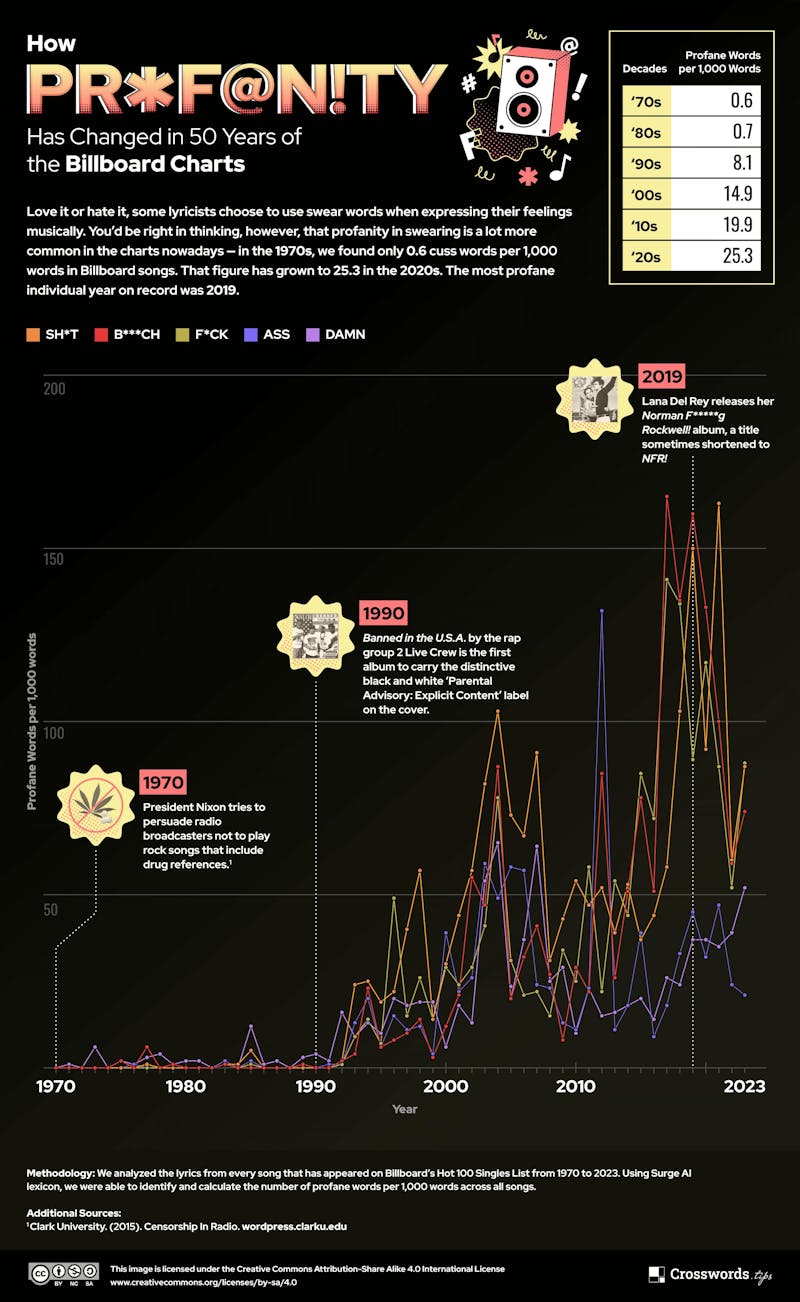How the Language of the Billboard Charts Has Changed in 50 Years (1970-2023)

We’ve come a long way from Simon & Garfunkel to The Weeknd & Ariana Grande. Both duos have topped the Billboard Hot 100 while capturing the zeitgeist with their sound. But after half a century — and a lot of troubled water under that bridge — the sound and the lyrics of today’s hit songs are very different.
Depending on which side of age 22 your inner music fan is, you may think music is changing for the worse. Bah, humbug! And sure, science has variously shown that pop music has become more droney in melody, timbre and loudness; more miserable in musical key; and simpler in rhythm (or more danceable, depending on the proclivities of that inner music fan).
But while many an armchair cultural commentator has claimed that pop music lyrics are becoming more repetitive, swearier and sadder, where are the stats to back them up? Word Tips has analyzed the lyrical content of over 5,000 top Billboard Chart hits since 1970 to see whether it’s true that today’s pop stars are cursing more, wailing more and repeating themselves.
What We Did
We began by compiling the lyrics of the 5,400 songs that made the annual Hot 100 Singles Lists from 1970-2023 from Genius.com and recording the number of words by song, year and decade. We then calculated the number of unique words and profane words for each song and each year.
Finally, we used an AI algorithm to determine whether each song was positive, neutral or negative in tone overall and measured how this has changed over the years and decades.
Key Findings
- 2023 was the year with the most diverse lyrics, with Billboard 100 artists using 185 unique words per 1,000.
- T-Wayne’s “Nasty Freestyle” (2015) is the most lyrically diverse hit of the 21st century, with 81.52% of the words only used once.
- Pop music contains 4117% more profanity in the 2020s than in the 1970s, rising from an average of 0.6 to 25.3 profane words per 100.
- Pop music is getting sadder: there was a 35.4% probability of a song being “negative” in the 1970s, rising to 48.1% in the 2020s — and peaking at 52.6% in 2019.
Are the Billboard Charts Getting More Lyrically Diverse?
First, we examined how hit artists have flexed their vocabulary over the years. We measured how many unique words per 1,000 appeared in Billboard End of Year Hot 100 songs from 1970 to 2023 and also grouped them by decade. And we found that, despite what Boomers might tell you, the level of diversity in lyrics has fluctuated regularly over those decades — and was actually at an all-time high in 2023. The average number of unique words per 1,000 hopped between 136 and 149 from the 1970s to the 2000s and is at 169 for the 2020s so far.
The worst year for vocabulary showboating was 1979, when songwriters averaged just 117 unique words per 1,000. That was the year of the Disco Demolition Night and the beginning of the end of disco — but as fabulous as the year’s hits were, songs like “I Will Survive,” “Hot Stuff” and “Y.M.C.A.” were designed for the dance floor, not the reading room. Add punk’s repetitive sloganeering and the fact that rap’s verbalists were yet to have their greatest impact, and 1979 was not a big year for words.
Things would not pick up again until the 1990s, when gangster rap, Britpop poetry and grunge introspection put meaningful lyrics back on the menu. A case in point was 1996, the decade’s high point for lyrical diversity, with an average of 176 unique words per 1,000. This was despite the Billboard 100 featuring both the “Macarena” and the “Macarena (Bayside Boys Mix).” However, lyrics were yet to have their most diverse moment — which we are living through right now in the 2020s.
Since 2020, Billboard hits have averaged 169 unique words per 1,000, eclipsing the lyrical diversity of the previous five decades. The most diverse so far this decade is Taylor Swift’s new take on “All Too Well,” with 74.33% unique words, including “plaid” and “tee-ball.” Swifties and music data geeks might like to know that her new version of “All Too Well” is measurably sadder than the original, too. Which brings us to our next data set.
Are Lyrics Getting Sadder?
Next, we used an AI algorithm that predicts whether the sentiment of a text is positive, neutral or negative in tone. And yes, the results are a bit of a downer: pop music is getting more negative. In fact, the odds of a Billboard End of Year Hot 100 song being negative overall have crept up from 35.4% in 1970 to 48.1% in 2023.
The great saddening has not been linear: 1989 is the tenth happiest year, for example. But the sadness has risen each decade, peaking in 2018 and 2019 when pop songs were briefly more likely to be sad than happy. The saddest song in 2019 was “Bad Guy” by Billie Eilish, which had an 85.82% negativity rating. And we’re suckers for it.
“Bad Guy” was also the Biggest Global Single of that year, according to the International Federation of the Phonographic Industry; it was the second most-played Spotify track and the most searched song on Shazam. It truly made your mama, your girlfriend and your dad sad. However, it was not the most negative song of the century so far. That accolade goes to Gwen Stefani’s “Hollaback Girl” (2005), whose negativity was reserved for Courtney Love, the song's target.
The most positive song of the century so far edges ahead of the competition before the title is even over: “Love You Like a Love Song” by Selena Gomez & the Scene (2012) has a positivity rating of 96.02%. The song is about the first flush of love, which songwriter Antonina Armato discussed with Gomez: “We were talking about the idea of this ultimate love that people strive for, where they would be willing to do anything for the person they love,” says Armato.
Selena Gomez highlights the secret behind the song’s success: “It’s one of those tracks that’s addictive because it’s kind of repetitive in the best way. It’s one of those songs that you can’t get out of your head.” Which brings us to our final test…
Does Pop Music Contain Profanity Today?
The top pop songs in the 2020s are more than 40 times swearier than their 1970s equivalents. In 1970, pop musicians didn’t give a single “sh*t,” nor a b***ch, f*ck, ass or damn, and across the whole of the 1970s, these words accounted for just 0.6 out of every 1,000 words. By 2019, there were 481 instances of these words across the Billboard End of Year Hot 100, and in the 2020s, the average so far is 25.3 profane words per 1,000.
1985 was a particularly coarse year — with more curse words than the rest of the 1980s put together. But things didn’t get really sweary until the 1990s and the mainstream popularization of gangster rap. Of course, pop music has always had its coarser aspects — what could be more popular than sex and complaining? — it’s just that until the 1990s, singers were likelier to wield a metaphor than an actual rude word.
However, we cannot blame potty-mouthed gangster rappers alone, since the rate of cursing has more than tripled since that decade. The introduction of Parental Advisory Labels by the Recording Industry Association of America (RIAA) in 1987 made profanity a literal badge of coolness. And audiences have sought more edgy and authentic music since the end of the 1980s, and the metaphor became suspect as grungy self-confession grew in popularity.
Profane words accounted for 1.99% of all lyrics across the Billboard End of Year Hot 100 in the 2010s. But an individual song, such as “Gummo” by 6ix9ine (2018), could have ten times as much swearing. The rudest song of the century so far is “Dance (A$$)” by Big Sean featuring Nicki Minaj (2012), in which 37.97% of the words are bleepworthy. In fact, Big Sean uses an alternative word for donkey some 88 times in the song — although “Dance (A$$)” doesn’t seem to be about a dancing donkey.
More Than Words
Generation-spanning artists, from Patti Smith to Billie Eilish, have proven that a big vocabulary is more about personal expression than the year you got out of high school. But, since our study focuses on the biggest hits of the year, our data highlights not just the trends in songwriting but in what we choose to listen to.
Today’s listener streams music that is less repetitive and upbeat, lyrically, than in 1970 — the year of “Raindrops Keep Fallin' on My Head” and the Jackson 5’s “ABC.” And if we lean towards songs with more swear words, well… isn’t that just a symptom of our ever-expanding musical vocabulary?
Methodology
To uncover how the language of the Billboard charts has changed in the last 50 years, we began by looking at the yearly Hot 100 Singles Lists from 1970 - 2023.
First, we compiled all songs (totaling 5,400) on the Billboard 100 since 1970 and obtained their lyrics from Genius.com. Then we removed all stopwords, non-Latin words and numbers from the lyrics and expanded common contractions like ‘you're’ to ‘you are’ and ‘talkin’’ to ‘talking.’ After that, we recorded the number of words by song, year and decade.
At a song and year level, we calculated lyrical diversity by dividing the number of unique words used by total words. At a year level, we consider this magnitude as the number of unique words per 1,000. At a song level, we consider it as a percentage of unique words (equivalent to the number of unique words per 100).
We then used Surge AI lexicon to measure how many of the words used in the songs were profane. We calculated this metric at a song, year and decade level. Year and decade-wise, we consider the number of profane words per 1,000 words. At a song level, we consider the percentage of profane words.
To evaluate the sentiment (i.e., emotional tone) of a song, we used an AI algorithm that predicts the sentiment of a text. The algorithm returns the probabilities of a text being positive, neutral or negative in tone. We used positive and negative probabilities as scores and ranked the songs accordingly — i.e., if a song has a high probability of being positive, it has a higher positive sentiment score.
Please note that songs with fewer than 100 words after removing stopwords, non-Latin words and numbers were filtered from the rankings.
Our data is correct as of March 2024.
Additional Sources
Caulfield, K. (2024). Morgan Wallen’s ‘One Thing at a Time’ Is Luminate’s Top Album of 2023 in U.S. billboard.com
Billboard Staff. (2011). 29 Black Music Milestones: Sugarhill Gang Pioneers Hip-Hop. billboard.com
Owen, F (1990). Belgium in the House. Spin Magazine. Vol. 5, no. 12. p. 21
Clark University. (2015). Censorship In Radio. wordpress.clarku.edu
Holmes, C. (2018). Sheck Wes Made a New ‘Mo Bamba’ — It’s Called ‘Kyrie’. rollingstone.com
Yi, J S; Caryl, C (2019). The year of the street protest. washingtonpost.com

About the author
Casey Wise
Casey Wise is a British journalist, creative copywriter, and music creator with a deep passion for language, travel, and technology. Based in Barcelona, his work extends from local start-ups and newspapers to university radio and the British NHS.





